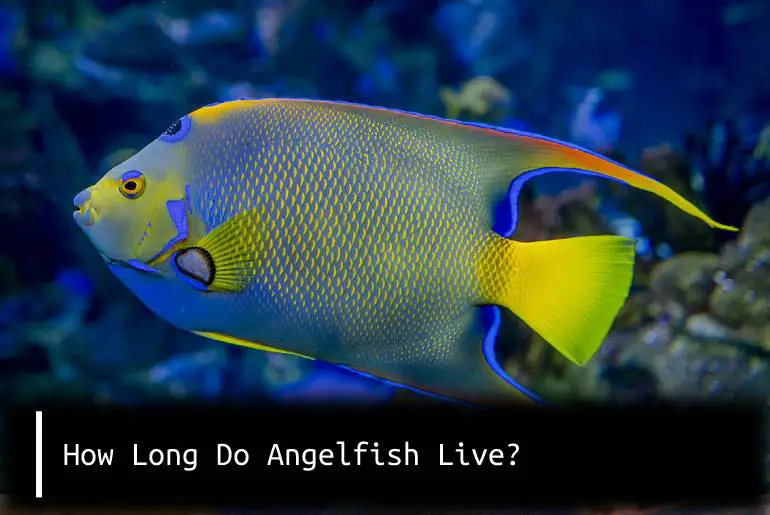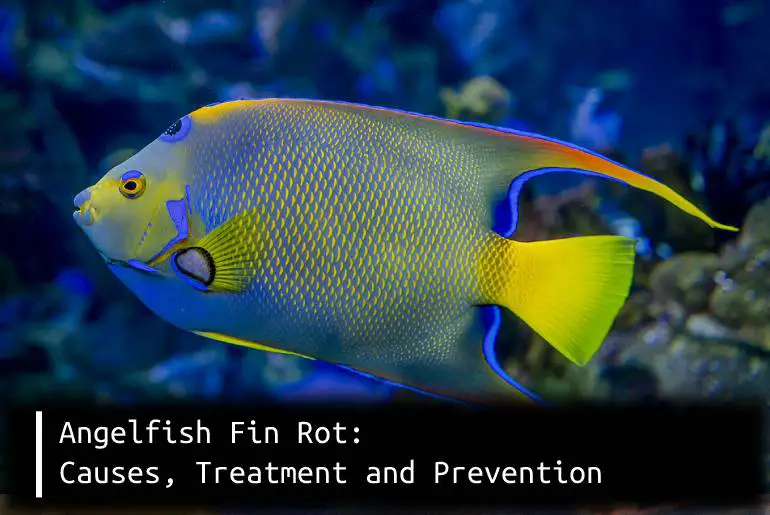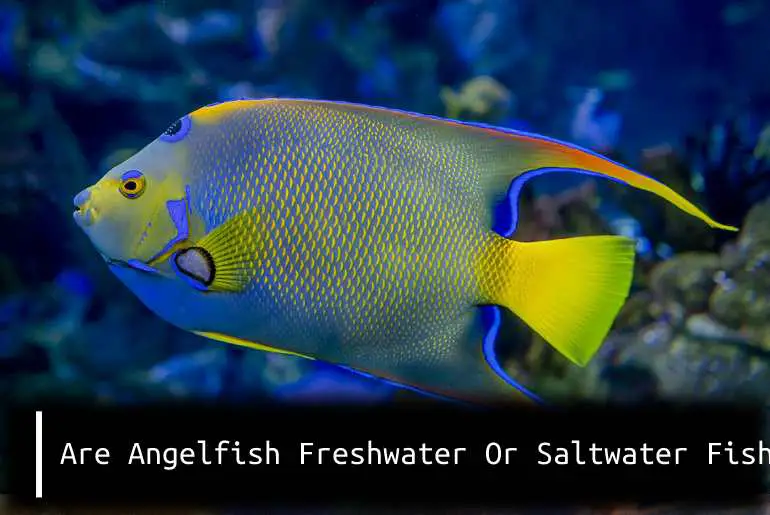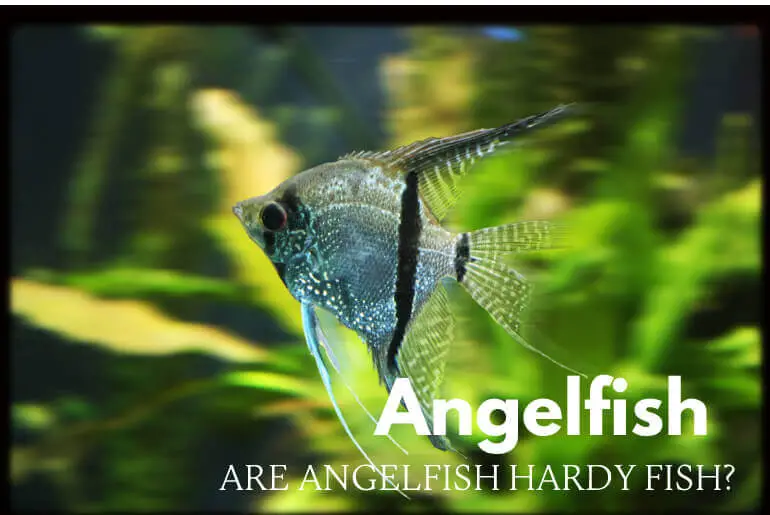When you first start to keep fish, you might face many challenges. Especially when the fish is as beautiful as angelfish and not soo hardy, even small environmental changes can wreak havoc. One of the most common problems that novice aquarists might encounter is when their angelfish starts to jerk or twitch. So, why do angelfish start twitching?
Twitching in angelfish is normal, but it might be an issue if your angelfish starts to twitch or jerk a lot. Other unusual causes of twitching are if another fish is chasing your fish or if another fish has nipped it.
If the twitching is accompanied by other symptoms like lethargy, loss of appetite, and clamped fins, it might signify disease or infection. In addition, excessive twitching can also occur due to stress, sudden change in water parameters, lack of food, or improper tank condition.
Generally, most aquarists assume twitching is normal and fail to see the underlying cause. But unfortunately, I have also faced a similar situation that ended up with the death of my fish. So, today I am here with you to share my experiences and help you out.
What Is Twitching?
Twitching is a sudden, involuntary movement of a muscle or group of muscles. It can be caused by many things, including stress, anxiety, fatigue, and even neurologic conditions. While twitching is usually harmless, it can sometimes signify something more serious.
However, if everything seems normal and your fish occasionally twitches, there’s probably no cause for alarm.
Some fish, like angels, are more prone to twitching than others. This is due to their anatomy and physiology. In addition, if the water quality is poor or the tank is overcrowded, this can lead to stress and anxiety, which can cause twitching.
Twitching can also be caused by physical trauma, such as being hit by another fish or getting stuck in a filter. Therefore, it is vital to be cautious when adding new fish to your tank. Please ensure they are compatible with your existing fish and that the tank is large enough to accommodate everyone.
Over time, you will get to know your fish and their personalities. This will help you identify when something is wrong.
Is Twitching Normal In Angelfish?
Yes! there’s no doubt that your active and mischievous angelfish loves to show different activities. And twitching is one of those. But, of course, if your angelfish is happy and healthy, then the occasional twitch is nothing to worry about. It’s normal for angelfish to twitch their fins and bodies occasionally.
This way, they can release any excess energy and keep themselves entertained. Besides this, twisting is also a habit that helps angelfish stay alert and agile. You might even notice jerking motions when they’re trying to capture prey.
If you see your angelfish twitching excessively or for long periods, it could be a sign of stress or illness. When this happens, it’s important to take a closer look at your fish and see if any other symptoms are present.
How To Know Twitching Is Serious In Angelfish?
Well! It’s not difficult to know whether the twitching of your angelfish is serious. Aquarists often oversee twitching, assuming it to be normal, which gradually ends up in the death of their beloved fish.
Therefore, it is very important to look at other signs of illness your angelfish might be exhibiting. Some common ones include:
- Loss of appetite
- Hanging at the surface more often
- Gasping for air
- Erratic swimming
- Clamped fins
In addition to twitching, all these signs could indicate a serious health condition in your fish that might require immediate medical attention. However, I usually try to address the cause of the twitching before taking medical help.
So, let’s look at a few causes of twitching.
Why Is My Angelfish Twitching?
While twitching of angelfish might fascinate some aquarists, it can also signify stress or illness. Therefore, if your angelfish is twitching, it’s important to determine the cause so you can take appropriate action.
Without knowing the reason behind your angelfish twitching, you should not ignore it as it might be an early sign of serious health concerns. So, what are the causes of twitching in your angelfish?
Generally, some of the reasons why your angelfish might be twitching are:
Expressing Happiness
Sometimes angelfish start twitching to express their happiness, especially when they are being fed. Yes, you read that right! Some angelfish owners have reported their fish twitching when they are happy and excited. It is a natural behavior of angelfish to twitch their fins when happy.
In such a case, you don’t need to worry about your angelfish as it is just expressing its happiness. However, if the twitching continues for a long time or your angelfish looks stressed, then it’s probably not happy, and you need to look into the matter.
Sudden Changes in Water Quality
One of the most common reasons behind fish twitching is changes in water quality. Yes, even a slight temperature or water pH level change can cause your angelfish to twitch. However, if the water quality is not up to the mark, it can also lead to other health problems in your fish, such as infections, fin rot, and white spot disease.
Moreover, angelfish are not as hardy as you might assume. Your angels are quite sensitive to changes in water quality and their environment. Most often, sudden or excessive change in water quality is the primary reason behind fish twitching.
Stress
While angelfish can adjust to some changes, they are very susceptible to stress. Just like humans, angels can also get stressed due to various reasons such as poor water quality, lack of food, aggressive tankmates, etc. When angelfish are stressed, they start twitching to cope with the situation.
Usually, when angelfish are stressed, they also stop eating and become lethargic. So it is probably stressful if you notice your angelfish twitching along with these signs. The best way to deal with a stressed angelfish is by creating a peaceful and stress-free environment.
Infections
If your angelfish is twitching and showing other signs of illness, such as lethargy, loss of appetite, and cloudy eyes, it might suffer from some infection. Angelfish are prone to infections, especially if the water quality is not up to the mark.
Some of the most common infections that can cause twitching in angelfish are bacterial infections, fungal infections, and parasites. If your angelfish is infected, it is important to treat the infection as soon as possible. Otherwise, it can lead to serious health problems or even death in your fish.
Sudden Change In Water Temperature
Angelfish are very sensitive to water temperature. Usually, the best water temperature for angelfish is between 72-82 degrees Fahrenheit. If the water temperature suddenly drops or rises, it can cause your angelfish to twitch.
Moreover, sudden changes in water temperature can also lead to other health problems in your fish, such as infections and fin rot. Sometimes aquarists fail to introduce or check the temperature of the water before adding their fish. As a result, the sudden change in temperature shocks the fish and causes it to twitch.
Attack Of Another Fish In The Tank
Angelfish are peaceful fish, and they generally get along with other tank mates. However, there are times when another fish in the tank might attack your angelfish. Usually, if you keep angelfish with aggressive fish such as Oscars, they might end up attacking your angelfish.
When other fish attack angelfish, they start twitching as a way to defend themselves. If you notice your angelfish being chased or nipped by other fish, it is probably time to remove the aggressor from the tank. Keeping your angelfish with the wrong tankmates is one of the most common reasons behind fish twitching.
Reaction To New Food
When you first introduce a new food to your angelfish, they might not be able to digest it properly. As a result, angelfish start twitching and may vomit the food. If you notice your angelfish twitching after feeding them new food, stop feeding them that particular food and try something else.
It is important to slowly introduce new food to your angelfish so they can get used to it. Otherwise, you might devastate their system, leading to various health problems.
To Establish Hierarchy Dominance
Angelfish are social creatures, and they generally live in groups. However, there is always a hierarchy in every group, and your angelfish might start twitching as a way to establish dominance over other fish.
In addition, during mating season, angelfish also start twitching as a way to attract mates. So if you notice your angelfish twitching and chasing other fish, it is probably looking for a mate.
While it is normal for angelfish to twitch during mating season, you should keep an eye on them to ensure they are not getting too aggressive.
Reaction To New Decorations
When you first introduce new decorations to your tank, your angelfish might not be able to adjust to the change. As a result, they start twitching and may even hide from the new decorations.
If you notice your angelfish twitching after adding new decorations to the tank, then try removing some of the decorations or rearranging them. Sometimes, all your angelfish need is some time to get used to the new decorations. So always remember to give them some time to adjust before making any changes.
There are several reasons why your angelfish might be twitching. In most cases, it is nothing to worry about, and your fish will return to normal once the stressor is removed. However, if your angelfish is twitching and showing other signs of illness, it is important to take action immediately.
But, how can you stop your angelfish from twitching?
How To Stop Angelfish From Twitching?
To be true to you, it is practically impossible to stop angelfish twitching. Believe me, I have tried millions of ways and failed miserably. Since twitching is a natural process, you will never be able to stop it completely.
The only thing you can do is to make sure that your angelfish are healthy and not under any stress. So, here are some ways to control the twitching of your angelfish:
Keep Angelfish In a Clean And Spacious Tank
The first and most important thing is to keep your angelfish in a clean and spacious tank. A dirty and cramped tank will only make the fish more stressed and cause them to twitch more.
Make sure you do regular water changes and keep the tank clean. This will help reduce the stress levels of your fish and minimize their twitching. In addition, angelfish are freshwater fish, so these tiny creatures thrive best in a freshwater environment.
If you want to experience the full beauty of angelfish, then it is important to keep them healthy and stress-free. A clean and spacious tank will help with that.
Provide Plenty Of Hiding Places
Twitching also results from bumping into things or getting startled. So, providing plenty of hiding places for your angelfish is important. This will help them feel safe and secure and reduce their twitching.
You can use plants, rocks, or anything else that can provide shelter for your fish. Ensure that the hiding places are not too small, or the fish will get stuck.
Don’t Overfeed Angelfish
One common mistake many aquarists make is feeding angelfish too much. This can lead to health problems and make the fish more stressed. As a result, they will start twitching more.
It is important to feed your angelfish the right amount of food. Overfeeding will not only cause them to twitch more, but it can also lead to serious health problems.
I usually feed my angelfish once daily, which seems to be enough. You can also try fasting your fish once a week to help them stay healthy. The bottom line is, don’t overfeed your angelfish and only give them the amount of food they can eat in one sitting. For this, you need to clean the tank after fifteen minutes of feeding.
Give Nutritious Food
Another way to reduce twitching is to give nutritious food. A healthy diet will help keep your fish stress-free and minimize their twitching. Many commercially available angelfish foods are full of nutrients.
You can also try live or frozen foods as they are even more nutritious. Moreover, some of the nutritious food options that I give my angels are brine shrimp, bloodworms, and daphnia. In addition, I also sometimes add a few greens to their diet.
Being omnivores, angelfish will enjoy eating both meat and plants. So, don’t forget to add some greens to their diet as well.
Some of the alternatives you can try out are as follows:
- Omega one pellets
- Ocean Nutrition Instant Baby Brine Shrimp 0.7-Ounces (20 Grams) Jar
- Omega One Freeze-Dried Blood Worms, 0.96 oz
- 200 Live Daphnia by Aqua L’amour
- Hikari Bio-Pure Freeze Dried Daphnia for Pets, 0.42-Ounce
- Hikari Tubifex Worms Fish Food (0.7 oz.) [Set of 2]
Avoid Using Harsh Chemicals
Many aquarists use harsh chemicals to clean their tanks. However, this is not a good idea as it can cause stress and make the fish more likely to twitch.
Just like humans, fish are also sensitive to chemicals. So, it is important to avoid using them in your tank. However, there are many safe and natural alternatives that you can use to clean your tank.
Mostly, your aquarium will be clean if you do regular water changes and use appropriate filters. However, if you still need to use chemicals, make sure you use safe and natural ones.
Maintain And Monitor Water Quality
Maintaining and monitoring water quality is important for a happy and healthy environment. This includes checking the temperature, pH, ammonia, nitrites, and nitrates levels.
All these factors play an important role in the health of your fish. So, keeping a close eye on them and ensuring they are within the normal range is important.
If you notice any changes, take appropriate measures to correct them. This will help reduce the stress levels of your fish and minimize their twitching.
Give Angelfish A Stress-Free Environment
Angelfish need stress free environment to grow and thrive. So, it is important to provide them with the right conditions. This includes proper tank maintenance, appropriate tankmates, the right water parameters, and a healthy diet.
Always keep your aquarium in a place where there is no direct sunlight and where it won’t be disturbed. Furthermore, introduce perfect live plants and substrates to make it look more natural and stress-free. If you do that, they will be healthy and happy, and their twitching will also reduce.
If you follow all these tips, your angelfish will have a happy and stress-free life. And as a result, their twitching will also reduce significantly.
Do you have any other tips on how to reduce angelfish twitching?
FAQs
Why Is My Angelfish Jerking?
There are a few reasons why your angelfish may be jerking. The most common reason is that the fish is having trouble swimming. This can be caused by several things, including poor water quality, overcrowding, or a lack of food. If your fish is jerking and you’re unsure why, check the water quality and ensure the tank is not too crowded.
Why Is My Angelfish Flicking Its Fins?
If your angelfish is flicking its fins, it could be a sign of communication. Angelfish use their fins to communicate with each other and with other fish in the tank. So if you see your angelfish flicking its fins, it’s likely trying to send attract a mate or warn other fish to stay away.
Why Is My Angelfish Shaking Its Head?
If your angelfish is shaking, it’s probably trying to eliminate parasites. Parasites are common in aquariums and can cause a variety of problems for fish, including poor health and death. Check for parasites and treat the fish accordingly, so if you see your angelfish shaking its head.
Why Is My Angelfish Shaking?
If your angelfish is shaking, it could be a sign of stress. Stress can be caused by several things, including sudden water change, aggressive tankmates, an unbalanced diet, or fluctuations in water parameters. If you see your angelfish shaking, try to identify the cause of stress and remove it from the tank.
Conclusion
Wrapping up, Angelfish are beautiful and intriguing creatures that make for great pets. So, if you notice your angelfish twitching, don’t be alarmed! In most cases, it’s nothing to worry about and is simply a result of them adjusting to their new home.
However, if the twitching persists or appears to be accompanied by other symptoms, it’s always best to find out the bottom of the issue and treat the problem immediately. Then, with a little angelfish care and attention, you can ensure your angelfish remain healthy and happy for years to come!
Thanks for reading! We hope this article helped clear up any confusion about why your angelfish might be twitching. Until next time, happy fishkeeping.






